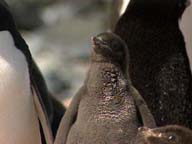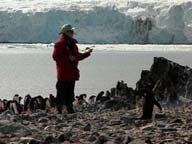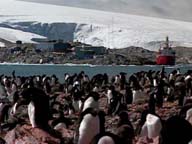
Journal of Carol Vleck
Date: Mon, 20 Jan 1997
From: Carol Vleck, Palmer Station
Carol Vleck is slated to be speaking with us from Humble Island during program 2, Jan 30, 1997. And she was a very welcome participant during our 1/16/97 test. This Journal only makes us all the more pleased she's making time at her busiest time of year to participate.
Subject: Ever wonder what a baby penguin feels like?

Adelie chick on Torgersen Island.
If you promise not to tell, I'll let you in on a secret. I really love stuffed animals. I can't bring myself to actually buy them for myself, but they are what I always buy for that friend with a new baby, or for my younger daughter when she wants one badly enough. The best way to pick out a really good stuffed animal, though, is to try it out. You stick it under your arm and walk around the store and see if it just feels like it belongs there, tucked up against your body.
Well, that's what a baby penguin is like. You just wish you could bring it home with you. Unfortunately my grocery store doesn't stock a lot of krill and even if it did, I'm afraid that baby penguin would grow up into a not quite-so-cute adult penguin (even though so of them can be pretty cuddly, too).

PI Carol Vleck studying penguins on Torgersen Island.
My group has been catching penguin chicks in the last week and (here's the gruesome part so some of you may want to stop reading here) taking a little bit of blood from them by pricking their foot and picking up a drop of blood in a capillary tube. I bet some of you have seen the nurses do this to your baby brother or sister in the hospital. We're interested in collecting this blood sample for several reasons. First of all, we suspect that some of the babies are being raised by penguins other than their real parents. How can that happen you ask? Part of the reason we suspect it occasionally happens is because when the male penguin comes back to colony in the early spring and doesn't find his previous mate, he may take a new mate. But if his old mate then comes back, he will often switch back to the old mate if she is strong enough to oust the first female. So the pair bonds are somewhat unstable early in the season before eggs are laid.
Another reason is that eggs sometimes roll around in the colonies on uneven ground and penguins can't stand to see an uncovered egg. They quickly scoop any available egg under their brood patch and then its theirs for the rest of the season. We will use the blood we collect from the chicks and from the parents to compare DNA among all the family members and see how closely related they are.
Another reason we take a small blood sample is to look at the development of the ability of the blood to carry oxygen that the birds need to be strong swimmers. When they first hatch, the chick's blood is very thin and watery. It is like they are badly anemic and in fact they certainly can't do much physical activity. But over the first few weeks of life they increase the number of red blood cells in the blood and put more and more hemoglobin into the blood. They aren't up to adult standards just yet -- they're still anemic, but they're getting stronger every day.
A penguin chick that is only a few days old is like a limp, old teddy bear. It can't hold up its head and it seems to be composed of nothing but head, feet and belly. In fact that's about all a baby penguin needs. Something to hold it up, to take in food, and to process that food into growing penguin.

Adelie penguin with chick, Torgersen Island.
They are covered with an incredibly dense coat of fluffy down that has the consistency of very thick velour or polar fleece (for those of you lucky enough to have a polar fleece jacket or neck gaiter you know what this is). Pretty soon the downy coat starts to fall out, though. It doesn't just come out gradually. It tends to come out in big wads looking like the dust "bunnies" that accumulate under your bed if you don't sweep very often. Their flippers seem to be too long for their bodies and without any bones inside. When they shake their little arms the chicks look like somebody wearing their father's overcoat with sleeves coming way down over their hands.
We banded some chicks a few days ago on a wet and miserable day. These little guys have grown so much that they are now about two- thirds the size of the adults (and they're only a month old!). Their down feathers were coming out to reveal underneath the sleek, water-proof feathers of a typical adult. The face, neck and flippers tend to be the first to "grow up". The downy fluff was matted down and dirty, the result of living in extremely crowded quarters with no washing facilities and with all the neighbors "processing" large amounts of krill. (It's hard to describe the odor). The dirty downy feathers were coming out of the chicks and sticking to us. Our hands were covered, our coats were covered, our clip boards were covered. At the same time we were trying to keep our papers and our tackle box with our supplies dry by huddling over it in the rain. It was a miserable experience for all concerned.

Adelie penguins on Torgersen Island with Palmer Station and Polar Duke in background.
We finally gave up and came home. We walked in, hung up our float coats on the hook outside the lab and you know what the first person who walked by said? "Boy, do you guys reek!" We all headed for the showers.
Carol Vleck




![]()
![]()